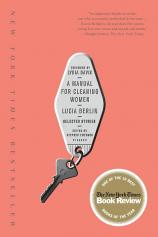Reading Group Guide
Discussion Questions
A Manual for Cleaning Women: Selected Stories

Introduction
A MANUAL FOR CLEANING WOMEN compiles the best work of the legendary short-story writer Lucia Berlin. With the grit of Raymond Carver, the humor of Grace Paley, and a blend of wit and melancholy all her own, Berlin crafts miracles from the everyday, uncovering moments of grace in the Laundromats and halfway houses of the American Southwest, in the homes of the Bay Area upper class, among switchboard operators and struggling mothers, hitchhikers and bad Christians.
Readers will revel in this remarkable collection from a master of the form and wonder how they’d ever overlooked her in the first place.
Questions and Topics for Discussion
1. In Lydia Davis’s introduction, we learn that many of Lucia Berlin’s stories are based upon events from her real life. In “Dear Conchi” the narrator writes, “I majored in journalism because I wanted to be a writer, but the whole point of journalism is to cut out all the good stuff.” In what ways does this observation epitomize many of the stories in the collection?
2. The secret ingredient of Berlin’s writing, according to Stephan Emerson’s introduction, is its suddenness. What examples of this suddenness did you come across in your reading and how does it propel the stories?
3. How would you describe Berlin’s unique prose style?
4. In the first story, “Angel’s Laundromat,” Berlin cleverly uses language from signs to set the mood of the piece, for example, “DON’T OVERLOAD THE MACHINES,” “NEVER LEAVE THE MACHINES UNATTENDED,” and” GOD GAVE ME THE COURAGE. NEW CRIB NEVER USED --- BABY DIED.” Why do you think Berlin uses this device and what affect does it have on the story?
5. A consciousness of class and socio-economic levels is present in nearly all of Berlin’s stories. In the title story, “A Manual for Cleaning Women,” the narrator observes, “Rich people in cars never look at people on the streets, at all. Poor ones always do…in fact it sometimes seems they’re just driving around, looking at people on the streets. I’ve done that. Poor people wait a lot. Welfare, unemployment lines, Laundromats, phone booths, emergency rooms, jails, etc.” What does the narrator mean by this? Do you agree?
6. In the title story, the narrator draws a comparison between working for American women “who are very uncomfortable about having servants” so they busy themselves with many tasks while the cleaning women visit, and Jewish and black women, who “respect work, the work you do, and also are not at all ashamed of spending the entire day doing absolutely nothing.” What is the narrator hinting at here?
7. Berlin uses humor in clever ways throughout the collection. For example, in “El Tim,” the narrator and schoolteacher, Mrs. Lawrence, describes the time on Monday mornings when she would always laugh. A very loud bang on the door would nearly always make her jump, but when the door opened it revealed “a tiny first grader” who, after requesting the cafeteria list in a whisper, “would tiptoe away and slam the door.” What role do humorous scenes like this one play in the stories? Did you find yourself smiling or laughing aloud at any point in your reading?
8. In “Point of View,” Berlin plays a sort of game with the reader. The narrator is working on a story and states that if the story is written in the first person, the reader would quickly become bored with the story, but with a change of point view --- that is, a shift to third person, the story will take on significance and thus the reader will empathize with the character. Berlin then goes on to write the story in the third person. What is it about the shift to third person that has this effect?
9. Throughout the collection, Berlin also provides a subtle (and sometimes not so subtle) social commentary. In “Tiger Bites,” while Bella and Lou are discussing the possibility of Lou getting an abortion, Bella says, “We’ll get you to a doctor here. They can save your life and everything in Texas. They just can’t do abortions.” What is it about fiction that makes it an appropriate and effective vehicle for exploring and discussing these sorts of issues?
10. In “Step,” the residents of the West Oakland Detox are in what the counselors call “the pit,” watching a boxing match. How does the boxing match on television mirror the situation in which the residents currently find themselves?
11. “The world just goes along. Nothing much matters, you know? I mean really matters. But then sometimes, just for a second, you get this grace, this belief that it does matter, a whole lot.” These are thoughts of the narrator in “Strays” while she and Bobby are watching the moon rise over the New Mexico desert. Has there even been a time when you felt similar?
12. “Fool to Cry” opens up with the line, “Solitude is an Anglo-Saxon concept. In Mexico City if you’re the only person on a bus and someone gets on they’ll not only come next to you, they will lean against you.” What does this observation reveal about the cultural differences between Anglo-Saxons and Mexicans? What other stories in the collection illustrate this and other cultural differences?
13. In the final story of the collection, “Homing,” the story shifts between the narrator’s present day and childhood, both of which closely align with Berlin’s own life. Toward the middle of the story, the narrator tells us about the mysterious and disappearing crows she has been seeing in her left eye. The doctor he tells her that these are floaters, that many people get them, that her “eye told the brain there was light so [her] brain believed it.” How does this scene work as a metaphor not only in the story but also in the collection as a whole? What is Berlin trying to say about truth and “what ifs” in this story?
A Manual for Cleaning Women: Selected Stories
- Publication Date: August 2, 2016
- Genres: Fiction, Short Stories
- Paperback: 432 pages
- Publisher: Picador
- ISBN-10: 1250094739
- ISBN-13: 9781250094735








